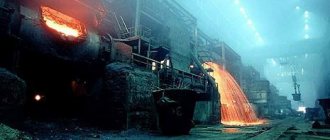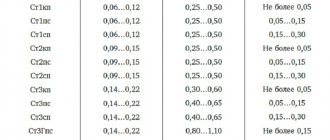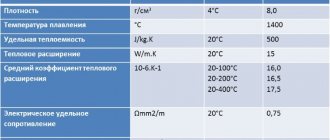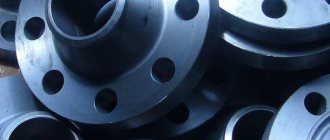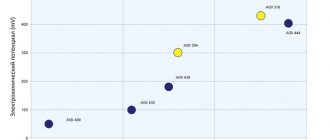Every year a lot of metal is lost due to corrosion. However, even greater damage is caused by the failure of metal products as a result of corrosion. The costs required to replace parts or routine repairs of instruments, cars, sea and river vessels, equipment used in chemical production, many times exceed the cost of the material used to manufacture them.
Indirect losses can also be significant. These include, for example, gas or oil leaks from pipelines damaged by corrosion, food spoilage, destruction of building structures, and much more. Therefore, the fight against metal corrosion is of paramount importance.
Why does metallic materials deteriorate?
Before moving on to the question of what corrosion-resistant steel is, let's understand the concept of corrosion and the essence of this process.
Translated from the Latin corroder - corroding. The slow spontaneous destruction of metals and alloys based on them, which occurs under the chemical influence of the environment, is called corrosion. The reason for this destruction is the chemical interaction (redox reactions) of metal materials with the gaseous or liquid medium in which they are located.
What are corrosion-resistant steels and alloys?
Products made of stainless and heat-resistant steel or their alloys are designed to work in aggressive environments at high or normal temperatures. Therefore, the main requirement for materials in this group is heat resistance (resistance to a gas environment or high temperature steam) or corrosion resistance (the ability to effectively withstand the effects of aggressive factors at normal temperatures).
Corrosion resistance is characteristic of metal products, on the surface of which in an aggressive environment a strong passivating film is formed, which prevents the penetration of aggressive substances into deeper layers of the metal and interaction with them.
In other words, corrosion-resistant steel is steel that is resistant to intergranular, chemical, electrochemical and other corrosion.
Groups of corrosion-resistant steels by structure
The structure of corrosion-resistant steels, their properties and areas of application are determined by the percentage of carbon, the list and amount of alloying additives. Based on its structure, stainless steel is divided into several types. Main: ferritic, martensitic, austenitic. There are intermediate options.
Ferritic
This group refers to low-carbon alloys - C up to 0.15%. Chromium content – up to 30%. The bulk crystalline structure provides a combination of fairly high strength and ductility. Stainless steels of ferritic grades are classified as ferromagnetic.
Main characteristics:
- ability to cold deformation;
- the main type of heat treatment is annealing, which removes hardening;
- good corrosion resistance;
- relatively low cost.
The main reason for the loss of performance characteristics of ferritic steels is intergranular corrosion (ICC), as a result of which destruction occurs along grain boundaries. To eliminate this negative phenomenon, sharp cooling of the metal from +800°C is avoided, stabilizing annealing is carried out, and an optimal balance is found between the carbon and chromium content. The introduction of carbide-forming elements—titanium and niobium—can completely eliminate the tendency to MCC.
According to the AISI standard, ferritic steels belong to the 400 series:
- 403-420 – chromium content 11-14%, no nickel;
- 430 and 440 – 15-18% C, no nickel;
- 630 – contains 3-5% nickel. It is well processed, resistant to corrosion in various environments, similar in properties to 08Х18Н10.
These materials are used in the production of a wide range of pipes, sheets, and profiles.
Table of grades of ferritic stainless steel according to GOST and AISI, main areas of use
| Brand according to GOST 5632 | AISI brand | Areas of use |
| 08Х13 | 409 | Cutlery |
| 12Х13 | 410 | Containers for liquid alcohol-containing products |
| 12Х17 | 430 | Containers for high-temperature processing of food products |
Martensitic
This group includes metals with a chromium content of up to 17%, carbon - up to 0.5% (in some cases - higher). Martensite is a structure obtained by hardening a workpiece and then tempering it. It is characterized by a combination of high hardness, strength, elasticity and corrosion resistance. Alloys are used in the production of critical metal products intended for use in aggressive environments. These are springs, shafts, knives, flanges. As the C content increases, a carbide phase appears in the structure, providing high hardness and wear resistance. Carrying out low tempering after hardening (+200...+300°C) provides high hardness - 50-52 HRC, high tempering (+500...+600°C) - lower hardness (28-30HRC) and higher viscosity. Hardening is carried out at temperatures of +950…+1050°C.
Table of martensitic steel grades according to GOST and AISI, their main areas of application
| Brand according to GOST 5632 | AISI brand | Areas of use |
| 20Х13 | 420 | Kitchen equipment |
| 30Х13 | ||
| 40Х13 | ||
| 14Х17Н2 (martensitic-ferritic) | 431 | Compressor unit parts, equipment operated in aggressive environments and at low temperatures |
Chemical composition
The properties of a metal are determined by its chemical composition. With a chromium content of 12-13%, steel becomes stainless, that is, stable in the atmosphere and chemical environments. An increase in chromium content to 28-30% makes it stable in aggressive environments.
Other elements used for alloying include manganese, aluminum, titanium, and nickel. The most widely used alloys are those containing an average nickel content of 10%, chromium - 18%, carbon - from 0.08 or 0.12%, titanium - 1% (12Х18Н10Т - corrosion-resistant steel, GOST 5632).
Grades of heat-resistant and heat-resistant stainless steels
Heat resistance, otherwise called “scale resistance,” is the property of a metal to resist gas corrosion at high temperatures in an unloaded or lightly loaded state.
Definition! To improve this characteristic, chromium, silicon and aluminum are introduced into the composition of stainless steels. These elements, combining with oxygen, form dense structures that increase the resistance of steel to temperatures above +550°C. Nickel by itself does not affect heat resistance, but in combination with Cr, Al and Si it increases their efficiency.
Heat-resistant steels are steels that function at high temperatures and loads without a tendency to short-term and long-term creep.
Table of areas of application of scale-resistant and heat-resistant steels
| Type | Brand | Temperature at which active reaction with air begins, °C | Areas of use |
| Chromium, scale resistant | X18 | +850…+900 | Equipment, products and structures operated at T up to +900°C without load |
| High chromium, scale resistant | Х25 Х25Т Х28 | +1100…+1150 | Metal products intended for operation without load up to T +1150°C, Х25Т – for the production of thermocouples |
| Silchrome, scale-resistant | Х25С3Н | +1100 | For heating units and heaters operating at temperatures up to +1100°C |
| Highly alloyed, scale resistant and heat resistant | Х23Н18 | Loaded products and structures intended for operation at T up to +1000°C | |
| Х20Н35 | Metal products operated at T +1000°C |
Classification by microstructure type: austenitic grade stainless steel
The resistance of this class to corrosion is increased due to the alloying elements of nickel (from 5 to 15%) and chromium (from 15 to 20%). Austenitic alloys are insensitive to intergranular corrosion, provided that the carbon content in them is less than its solubility limit in austenite (0.02-0.03% or less). Non-magnetic, well subject to welding, cold and hot deformation. They have excellent technology. This is the best steel for the manufacture of fasteners, welded structures and use in various industries.
Stainless steel grades for the manufacture of chimneys
When purchasing modular chimney systems, you need to find out what kind of steel they are made of. On sale you can find chimneys that are about one and a half times cheaper than other products in this category. In their production, AISI 201 steel (12X15G9ND) is used. According to international standards, it is necessary to use steel grade AISI 321 (08Х18Н12Т), the cost of which is approximately 2 times higher than the cost of AISI 201. It is impossible to visually distinguish AISI 201 from AISI 321, moreover, both alloys are non-magnetic. They can only be distinguished by chemical analysis.
Differences in chemical composition
| Brand | WITH | Mn | P | S | Si | Cr | Ni | Cu | Ti |
| AISI 201 | Up to 0.15% | 7-9,5 | Up to 0.1% | Up to 0.03% | Up to 1.0% | 13-18 | 0,3-3,0 | 0,5-2,5 | — |
| AISI 321 | Up to 0.08% | Up to 2.0 | Up to 0.05% | Up to 0.03% | Up to 1.0% | 17-19 | 9,0-12,0 | — | Min 0.5% |
AISI 201 steel has low anti-corrosion characteristics, instability of the structure, and the risk of cracks during drawing. Its use will lead to rapid failure of the chimney due to rapidly developing corrosion. This steel is mainly distributed in China and India.
Well-known foreign and conscientious Russian manufacturers, in addition to AISI 321 steel, use high-alloy alloys stabilized by Ti. They are acid and heat resistant. The use of cheaper steels (AISI 409, AISI 430) for gas exhaust pipes that do not meet acid resistance requirements leads to their failure soon after the start of the heating season.
Austenitic-ferritic class
Corrosion-resistant stainless steels of this class are characterized by a reduced nickel content and a high chromium content (from 21 to 28%). Additional alloying elements include niobium, titanium, and copper. After heat treatment, the ratio of ferrite and austenite is approximately one to one.
The strength of austenitic-ferritic steels is twice that of austenitic steels. At the same time, they are ductile, resist shock loads well, have a low level of stress-corrosion cracking and high resistance to intergranular corrosion. Recommended for use in construction, manufacturing industry, and for the manufacture of products that will come into contact with sea water.
Stainless steel: price (factors influencing formation)
Corrosion-resistant metals include expensive alloying elements such as chromium, nickel, titanium, and molybdenum. Their cost is decisive in pricing. Since other grades (carbon, structural, ball bearing, tool, etc.) contain the listed elements in much smaller quantities, the cost of corrosion-resistant steels is always higher in comparison with them. However, the price may vary depending on market conditions and the costs required to produce stainless steel.
Classification of alloy steels
Based on the percentage of alloying elements in the composition, stainless steel is divided into the following classes:
- Low alloy steel (less than 2.5%)
- Medium alloy steel (2.5 – 10%)
- High alloy steel (more than 10%)
Nickel, molybdenum and chromium are usually used as auxiliary components for low-alloy steels. Some of the most common grades of steel in this group are: 13Х (used for the manufacture of jewelry, engraving and surgical equipment), heat-resistant structural low-alloy steel 12Х1МФ (used in the production of pipelines, flanges, cylinder parts, etc.) The properties of low-alloy steels make it possible to reduce the weight of structures and save metal due to its high yield strength, improves the performance characteristics of the final product.
The composition of medium-alloy steel may include nickel, tungsten, molybdenum, and vanadium. Thermal and mechanical treatment allows you to achieve an optimal balance of strength, toughness and ductility. Medium-alloy steel is indispensable in mechanical engineering, shipbuilding, for the manufacture of various parts (drills, reamers, etc.). For example, such popular brands as 9Х5ВФ, 8Х4ВЗМЗФ2 are calcined at higher temperatures than low-alloy steels; they are more durable and strong.
The main additional elements of high-alloy steels are chromium and nickel. Thanks to their high content, the metal receives such unique properties as: resistance to extreme temperatures, corrosion resistance, heat resistance. High-alloy stainless steel owes its exceptional characteristics not only to its chemical composition, but also to subsequent processing. For example, steel grade 12Х18Н10Т, resistant to nitric acid and other aggressive influences, is ideal for welded structures; steel 08Х14МФ is used for the production of stainless pipes and food industry equipment.
In addition to classification according to the content of alloying elements, alloy steel differs in structure (pearlitic, martensitic, austenitic, ferritic, carbide), by purpose (special purpose, structural, instrumental) and other parameters.
Mechanical properties
Grades of corrosion-resistant steels must have mechanical properties that meet the requirements of established manufacturing standards. These include:
- maximum hardness on the Brinell scale (HB);
- relative extension (%);
- yield strength (N/mm2);
- tensile strength (N/mm2).
After production, each batch (melting) of commercial products is checked for compliance of the mechanical properties and microstructure of the steel grade with GOST. The results of laboratory testing of samples are indicated in the manufacturing certificate.
Steel grade designation system
A wide range of alloys and steels are produced in various countries around the world. However, there is not yet a unified international system for their labeling.
There are several naming systems in use in the United States of America. This situation, due to the presence of a large number of standardization organizations (AJS, ANSI, ACJ, SAE, AWS, ASTM, ASME), creates certain difficulties for partners, contractors and customers of metal products from American manufacturers from other countries.
In Japan, steels are marked with letters and numbers indicating their group (low-alloy, high-alloy, special-purpose alloys, medium-alloy, high-quality, high-quality, etc.), the serial number in it and the properties of the metal.
In the countries of the European Union, designations are regulated by the EN 100 27 standard, which determines the procedure according to which the name and serial number are assigned.
The Russian Federation uses an alphanumeric system developed during the Soviet Union, in accordance with which steel grades are designated. GOST requires that each alloying chemical element included in the metal be indicated in a capital Russian letter.
For manganese it is G, silicon - C, chromium - X, nickel - H, molybdenum - M, tungsten - V, vanadium - F, titanium - T, aluminum - Yu, niobium - B, cobalt - K, zirconium - C, boron - R.
The numbers following the letter indicate the content of alloying elements as a percentage. If the steel contains less than 1% of the alloying element, then the number is not entered; if the content is from 1 to 2%, a 1 is placed after the letter. The two-digit number indicated at the beginning of the grade is necessary to indicate the average carbon content in hundredths of a percent within the grade composition.
Range of products made from stainless steel
Corrosion-resistant steel is used to produce the following products:
- heat-treated etched and polished sheets;
- heat-treated unetched sheets;
- thermally untreated and unetched sheets;
- warm, cold and hot-deformed seamless pipes;
- hot-rolled steel strips for general purposes;
- calibrated hexagons;
- stainless steel circles;
- stainless steel wire (heat-treated and cold-drawn);
- castings with special properties;
- forgings;
- other types for which GOSTs and technical instructions (TU) have been developed.
Application area
Being one of the best examples of strength, aesthetics, resistance to the destructive forces of corrosion and high temperatures, recyclability and durability, having an excellent surface finish that meets all sanitary and hygienic requirements, corrosion-resistant steel is widely used in almost all areas of economic activity. activities.
Stainless steel is in high demand in the petrochemical, chemical, pulp and paper, food industries, construction industry, electric power industry, shipbuilding and transport engineering, in the fields of instrument making and environmental protection.
The efficiency and durability of products made from stainless steel is determined by the correct choice of its class and grade, understanding of the physical and chemical properties and microstructure. By using metals that are resistant to the destructive effects of corrosion, in strict accordance with their properties, we are able to take advantage of all the undeniable advantages of modern technologies.
Stainless steels for the food industry
Corrosion-resistant steels are indispensable for industries producing equipment, tools and utensils intended for contact with food products. Their advantages:
- Resistance to various types of corrosion - chemical and electrochemical. In each specific case, it is necessary to select brands that are resistant to the environments with which they will come into contact during operation. These are normal atmospheric conditions, water, salt water, acidic, alkaline, chloride solutions.
- Good machinability. Modern tools make it possible to weld, cut, form and process corrosion-resistant alloys on lathes, milling and drilling machines in the same way as “ferrous” steels.
- Compliance with sanitary and hygienic standards. Thanks to various processing methods - grinding, polishing to a mirror finish - a surface is obtained that is practically free of pores and cracks into which dirt and pathogenic microorganisms can penetrate.
- Good mechanical characteristics. Thanks to them, it is possible to produce products and structures of smaller thickness and weight without compromising technical properties. Austenitic steels are more resistant to low temperatures compared to general purpose metals.
- Aesthetics. Electropolishing, satin finishing and other surface treatment methods provide a stylish look to stainless steel products.
Read also: How to replace a fuse in a microwave oven
Table of properties and areas of application of food grade stainless steels
| Steel grade according to GOST | AISI | Characteristics | Areas of use |
| 304 | 08Х18Н10 | It welds well, can be electropolished, retains high strength at normal and low temperatures, and is resistant to intercrystalline corrosion. | Equipment, tools, technological pipelines of food, petrochemical, pharmaceutical and medical industries, for utensils intended for high-temperature processing of products are not used |
| 316 | 03Х17Н14М2 | The presence of molybdenum increases the technical characteristics of the alloy at high temperatures | Installations, technological equipment, containers for the food and chemical industries |
| 321 | 12Х18Н10Т | Good weldability, maintaining performance characteristics at temperatures up to +800°C | Equipment for the chemical and oil refining industry |
| 409 | 08Х13 | Characteristics are satisfactory | Crockery and cutlery |
| 410 | 12Х13 | Heat resistance, resistance only to mildly aggressive environments | Winemaking equipment, alcohol containers |
| 420 | 20Х13-40Х13 | Versatility, ductility, wear resistance, increased corrosion resistance | Dishes, kitchen sinks |
| 430 | 08Х17 | Strength, thermal conductivity, good machinability, corrosion resistance | Utensils for heat treatment of products, including steam |
| 439 | 08Х13 | Possibility of use in various operating conditions | Alloy for mass use - production of refrigerators, sinks, washing machines |
Table of stainless steel grades used in the food industry
It is impossible to imagine modern life without anti-corrosion steel. The development of such an alloy has made it possible to make a qualitative breakthrough not only in metallurgy, but also in many other areas. Stainless steels differ from classical ones in that in addition to iron and carbon, they also contain chromium. It is the addition of chromium that gives the alloy anti-corrosion properties.
Stainless steel products are very diverse. You can find a wide selection of products from any manufacturer. For example, high-quality products, as confirmed by numerous reviews, can be ordered in the BSM - Metal online store.
